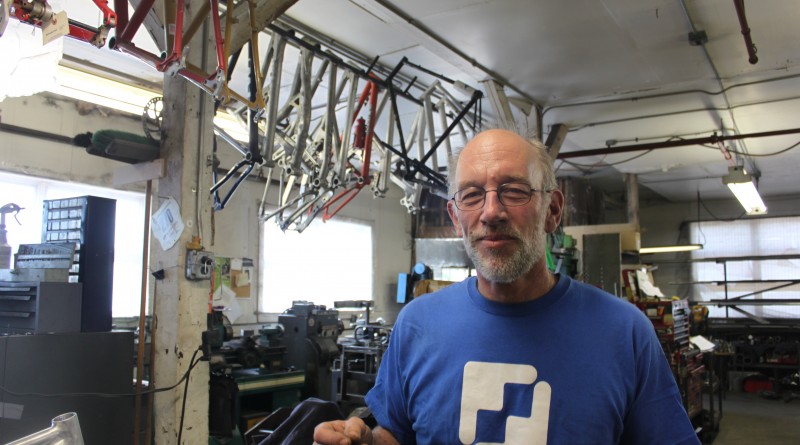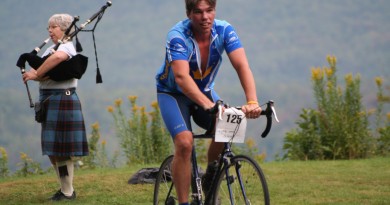Go See Frank
Bellows Falls —Sparks from a grinder hit the floor and the tangy scent of oil hangs in the air of this workshop. Standing at a workstation, Frank Wadelton, 54 — better known to the national biking community as “Frank the Welder” — bends his head in focus and lets the sparks fly.
Wadelton’s designs have touched every variation of the cycling world, including mountain and road biking, downhill, trials, BMX and the newer varieties of fatbikes and ski bikes.
So if you want to talk bike design, you go see Frank.
Wadelton’s story starts in Hollywood, California, when he was “modifying” his sister’s Schwinn Stingray in 1973 and taking it out on rides of his own. That same year, he first noticed the earliest models of mountain bikes with multiple gears.
To the 14 year-old, it was an epiphany.
“Until then, biking for me had been a basic means of transportation,” he says. “But those bikes made me realize what I wanted to do.”
Wadelton developed his skills as a welder and found that he could balance making bikes with other tasks, such as welding on bridges or making road signs — things he could make a living from. After work, he would work from quitting time until early morning on his experiments with bikes.
“In my free time I drove around with a motocross bike in the back of my Blazer and slept on the beach,” he recalled. “Good times.”
He knew he wanted to make bikes and with the early mountain bikes taking the market by storm, he found an “in” with bike manufacturer Mongoose, where he was a shift manager and a production engineer.
After Mongoose moved their fabrication abroad he was invited to join Yeti, a new company started by John Parker and Chris Herting. The company started out as a team of three; Parker brought the business know-how, Herting was the mechanic and Frank was in charge of design and production.
The company started in a burned-out bar in San Fernando before moving to an empty space in a Hollywood prop shop. Using the resources of the space, they were able to work on the bikes at night while fabricating props for movies or commercials during the day.
When a director couldn’t pronounce his last name and referred to him by his trade, the name “Frank the Welder” stuck.
Meanwhile, the sport continued to grow. Races were springing up around the country and the National Off Road Mountain Biking Association (NORBA) started up with just 112 riders.
“It was a time when everything you were doing was of interest to people,” he says. “When we went to races, people were five-deep at the trade shows. We were just a bunch of kids onto something that was going gang-busters.”
As the sport grew, many of the people that had been in the shop became more interested in designing the products for others to build overseas. The business of constructing bikes changed, he says, but not in a direction he was comfortable with. He left Yeti in 1992 to pursue a more hands-on approach.
“I could make money designing stuff for someone else to make, but I happen to like making things,” he says. “So I decided to stick with that. I helped small brands start up so I could do the prototype and development work. I’ve always liked to develop new things and to get paid for it, I’ll make whatever anyone else wants using my capabilities.”
Frank continued his work with various start-ups and came east to Connecticut to work for Spooky Bikes in 1995, later transferring to a new startup, Sinister in Bellows Falls in 1999.
Wadelton says he found the new surroundings to his liking.
“I found that the more north and east I got, the better the riding got,” he says. “It gets a little harder to survive, but it keeps all the weenies out. I fell in love with this place.”
When Wadelton wasn’t making bikes, he was racing them. He placed sixth in the world championships at Bromont Mountain in Quebec in one mountain bike race and even raced at the first NORBA races at Mount Snow in Dover. The race tags and medals from his 13 consecutive years of racing are nailed to the walls of his workshop.
When the principal investors of Sinister wanted to back out, Frank was able to buy the company at a bargain basement price in 2007. He later sold it and as part of his separation with Sinister, they helped set him up in his current workshop in Bellows Falls. He’s been working there since.
The nondescript building just off U.S. Route 5 is one of the oldest buildings in town and has at various points served as a slaughterhouse, shoe factory and a safe house on the Underground Railroad (a 125-foot shaft under the bathroom leads to the Connecticut River in the event of a quick escape). When he was working out West, he was able to subcontract or outsource some portions of production. Now, he has the means to complete almost every phase in his shop.
Wadelton’s work is, as he puts it, “hardly cut and dry” and can involve any number of projects at any given time. Some projects are more secretive and require nondisclosure agreements, but he readily describes himself as a “gun for hire” and can do whatever the job requires – ranging from early phases of product development to restoration of older models he designed years ago.
His variety of talents allows him to occupy a niche all his own within a huge industry and he says he’s struck a balance between the work that he really wants to do, and the work that gives him the freedom to pursue his passions.
“You don’t want to do anything that’s completely stupid,” he says. “Doing something that’s a little stupid and getting by is fine. That’s healthy living when you can find that balance and I think I’ve been able to do that here.”
His list of accomplishments within the industry is impressive, and includes:
• Helping develop Easton frame tubes
• Fabricating the first set of two-fingered Shimano brake levers
• Welding first set of two-sided clipless pedals for Don Mirah
• Designing A-tac stem for Answer products
• Designing new bar ends for Onza
• Co-designing all Yeti frames
• Pioneering the “soft tail” design currently popular on XC bikes
• Developing use of plastic bushings in pivots
• Designing tires and grips with Yeti
He’s also build frames out of aluminum, titanium, steel, metal matrix composite (and even a wooden unicycle) for riders like John Tomac, Juli Furtado, Lisa Muhic, Tinker Juarez, Brian Lopes, Miles Rockwell, Missy Giove, Sarah Ballentine, Don Mirah, Daren and Kurt Stockton, Davis Phinny, Greg Orovits, Leigh Donovan, Jimmy Deaton, Russ Worley and others among the top riders in the world.
Not only his Wadelton one of the top bike-builders in the country, his shop doubles as a history museum. Early prototypes, current models or rebuilt versions of older, discontinued models hang from the ceiling on pegs and, in the back, are even older models of bikes – all fully restored by Wadelton himself – clustered wherever there is available space. Walking around, Wadelton can point to any bike and give its name, age, and defining features.
When asked why so many, he grins.
“Wheels, man. It’s all about the wheels.”
More specifically, the master bike builder insists the bikes clustered in corners and hanging from beams aren’t just rare items, for him they’re important examples of design and craftsmanship. Some are more exemplary than others but for a master craftsman, they’re case studies of what worked and what failed.
“I love nuts and bolts, technology and the way things work,” he says. “And all of these bikes have qualities about them that make them unique. They all have something that means something to me beyond the fact that it’s a device; the technology that goes into them marks a point in time.”
From his modified rides made a kid to designing industry standards, Wadelton says producing the bikes is a “cure for everything.”
“I get up and go to work, where it’s safe,” he jokes. “Nobody comes in here to hassle me.”
He’s done all of this without a high school diploma and has taught himself everything from metallurgy to HTML coding. He’s designed and made his own tools and machines for shaping, bending, cutting and everything else he needs.
Wadelton takes pride in his work found in the people willing to go the distance for their craft and for him, and says the camaraderie among riders is the best reward.
“You meet the nicest people on bikes,” he says. “And being able to make a living is just icing on the cake.”



Pingback: Vermont Sports Magazine | Your Guide to the Outdoors in Northern New England